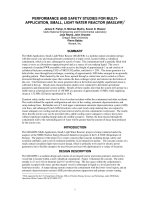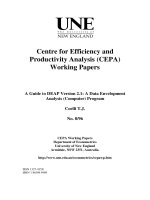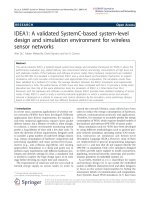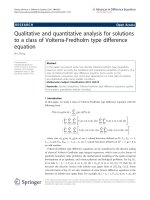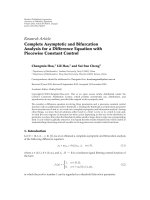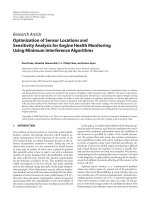Firm level performance and productivity analysis for software as a service companies
Bạn đang xem bản rút gọn của tài liệu. Xem và tải ngay bản đầy đủ của tài liệu tại đây (717.96 KB, 94 trang )
FIRM-LEVEL PERFORMANCE AND PRODUCTIVITY
ANALYSIS FOR SOFTWARE-AS-A-SERVICE
COMPANIES
WANG MENGQI
(M.Sc.), NUS
A THESIS SUBMITTED
FOR THE DEGREE OF MASTER OF SCIENCE
DEPARTMENT OF INFORMATION SYSTEMS
SCHOOL OF COMPUTING
NATIONAL UNIVERSITY OF SINGAPORE
2009
Acknowledgements
The author gratefully acknowledges Dr. Huang Ke-Wei, who is the supervisor, for his
patient help in supervision and guiding the research.
Also, thanks my friends Luo Huawei and Chen Yifan for their valuable suggestions in
econometrics.
2
Table of Contents
SUMMARY .................................................................................................................................................... 4
List of Tables................................................................................................................................................... 5
1.
Introduction ........................................................................................................................................... 6
2.
Background and Literature .................................................................................................................. 12
3.
4.
5.
2.1.
The Software-as-a-Service Business Model ................................................................................. 12
2.2.
Benefits and Shortcomings of SaaS.............................................................................................. 15
2.3.
ASP, On-Demand Computing, and SaaS ..................................................................................... 17
2.4.
IT and Productivity ...................................................................................................................... 21
Data Collection and Firm Categorization ............................................................................................ 31
3.1.
Data Collection............................................................................................................................ 31
3.2.
Dummy Variable for Firm Categorization................................................................................... 32
Analysis of Firm Performance ............................................................................................................. 34
4.1.
Research Model ........................................................................................................................... 34
4.2.
Data Analysis ............................................................................................................................... 37
4.3.
Discussion and Implications ........................................................................................................ 38
4.3.1.
Discussion ........................................................................................................................... 38
4.3.2.
Implications......................................................................................................................... 40
Analysis of Firm Productivity.............................................................................................................. 41
5.1.
Research Model ........................................................................................................................... 42
5.1.1.
Empirical Models ................................................................................................................ 42
5.1.2.
Variable Constructions ....................................................................................................... 44
5.2.
Data Analysis ............................................................................................................................... 48
5.2.1.
Economies of Scale ............................................................................................................. 50
5.2.2.
Marginal Product of Input Factors ..................................................................................... 50
5.2.3.
Total Factor Productivity.................................................................................................... 54
5.3.
Discussion and Implications ........................................................................................................ 57
5.3.1.
Discussion ........................................................................................................................... 57
5.3.2.
Implications......................................................................................................................... 62
5.4.
Robustness Check ........................................................................................................................ 63
5.4.1.
A Reduced Sample............................................................................................................... 63
5.4.2.
Using Other Regression Methods ....................................................................................... 68
6. Conclusion................................................................................................................................................. 77
References ..................................................................................................................................................... 82
Appendix 1 .................................................................................................................................................... 90
Appendix 2 .................................................................................................................................................... 94
3
SUMMARY
The Software-as-a-Service (SaaS) business model is that, the vendors host their software
application on their own servers, release it to several customers at one time through the
internet using a multi-tenant architecture, and charge the customers by a recurring
monthly subscription model. This new software management model has been place great
expectation on as a more efficient software business model and as a future trend of the
industry.
This research uses firm level financial data of software vendors from 2002 to 2007. We
categorize software vendors into three groups: pure-SaaS vendor, mixed-SaaS vendor,
and non-SaaS vendor. This categorization is used as the most critical dummy variable of
the following analysis. We first build a performance model for SaaS business and study
the effect of different business model on firm performance. Then we analyze how these
three models affect the productivity of the vendor company. We build two Cobb-Douglas
production models – balance sheet model and income statement model – using different
combination of inputs and output. The productivity of software companies is evaluated
from three aspects: economies of scale, marginal product of input factors and total factor
productivity. Our results indicate that SaaS model has significant differences to
conventional model in all three aspects. Especially, we find out that pure-SaaS
companies have less scale economy than traditional packaged software companies,
which breaks the existing common expectation of large economies of scale on SaaS
model.
Keywords: Software-as-a-Service, Economies of Scale
4
List of Tables
Table 1. Data Sources, Construction Procedures and Deflators for Performance Analysis
........................................................................................................................................... 36
Table 2. Summary Statistics for Performance Analysis ................................................... 36
Table 3. Results of OLS Assuming Unequal Variance..................................................... 37
Table 4. Robust Check of Standard OLS Assuming Equal Variance ............................... 38
Table 5. Data Sources, Construction Procedures, and Deflators for Productivity Analysis
........................................................................................................................................... 46
Table 6. Model Constructions for Productivity Analysis ................................................. 47
Table 7. Summary Statistics for Productivity Analysis .................................................... 48
Table 8. Economies of Scale (PCSE) ............................................................................... 50
Table 9. PCSE Estimates of BS Model............................................................................. 50
Table 10. PCSE Estimates of IN Model ........................................................................... 51
Table 11. Total Factor Productivity (PCSE) ..................................................................... 55
Table 12. Comparison of Total Asset ............................................................................... 63
Table 13. Reduced Sample Economies of Scales (PCSE) ................................................ 64
Table 14. Marginal Product of Reduced Sample .............................................................. 64
Table 15. Total Factor Productivity (Reduced Sample, PCSE) ........................................ 65
Table 16. Economies of Scale (FGLS, FE, and RE) of BS Model ................................... 68
Table 17. Economies of Scale (FGLS, FE, and RE) of IN Model.................................... 69
Table 18. FGLS, FE, and RE estimation of BS Model ..................................................... 70
Table 19. FGLS, FE, and RE estimation of IN Model ..................................................... 71
Table 20. Total Factor Productivity (Full Sample, FGLS) ............................................... 73
Table 21. Total Factor Productivity (Reduced Sample, FGLS)........................................ 73
Table 22. Total Factor Productivity (Full Sample, FE) .................................................... 74
Table 23. Total Factor Productivity (Reduced Sample, FE) ............................................. 75
Table 24. Total Factor Productivity (Full Sample, RE) .................................................... 75
Table 25. Total Factor Productivity (Reduced Sample, RE) ............................................ 76
5
Main Body of Thesis
1. Introduction
Software-as-a-Service (SaaS) is a newly emerged software delivery business model.
It is expected to be a growing trend for enterprise software vendors in the future. As
early as in 2000, it was predicted that there would be a brand-new landscape for the
future of software, in which a development called “servicization” would be a great
revolution (Hock et al. 2000). After that, the Application Service Provider (ASP, a
similar term to SaaS) model emerged and the favor of IT outsourcing market
gradually transmits from on-premise software packages towards on-demand software
services (Sääksjärvi et al. 2005). It was expected by the industry that the SaaS model
would cause “a sea change” in the software industry (Software & Information
Industry Association (SIIA) 2001). In the following years, this prediction was proved
by the market both from the vendor side and from the client side. From the vendor
side, the SaaS suppliers won highly appreciation from venture capital investments
(Akella and Kanakamedala 2007). In a survey about SaaS, it was discovered that
companies with SaaS as their main business had a revenues rise by 18% from 2002 to
2005, which was from $295 million to $485 million (Dubey and Wagle 2007). In
another report about SaaS business, it was forecasted that the revenue of worldwide
software-on-demand (a similar term to SaaS) would grow from $4,000 million USD
in 2007 to $15,000 million USD in 2011, which would be a growth from 2% to 5% in
total software market revenue (TenWolde 2007). In terms of annual growth rate, it
was indicated that the annual growth rate of SaaS would be 22.1% through 2011 for
the aggregate enterprise application software markets, which would be higher than
6
twice of the growth rate of the total enterprise software (Mertz et al. 2007). Also,
around 10% of the enterprise software vendors expected to transform into pureplaying SaaS vendors by 2009 (Traudl and Konary 2005). From the client side, SaaS
is a demand-centric software delivery model received great acceptance across various
different industries. In October 2006, 64% of 72 senior IT executives claimed in a
survey that they were planning to implement service-oriented architectures in 2007
(Akella and Kanakamedala 2007). And this intension was proved to be common
among these potential clients of SaaS by another industry research report (Traudl and
Konary 2005).
Software as a service is a model of internet-based software deployment in which the
vendors provide their application to customers as a service based on usage. The
application is usually hosted in the vendors’ own hardware, and they take up the
maintenance and security of these devices as well. In contrast, the conventional
software vendors sell the software to customers at a one-time large fixed licensing fee,
and next install, maintain, upgrade the software application on the buyer’s machine.
Salesforce.com, a vendor of online Customer Relationship Management (CRM)
application, is regarded to be the most successful SaaS adopter. Since 1999, it started
their CRM business. After its IPO in 2004, their revenue stride up from 176.4 million
to 748.7 million while its stock return increased by 364%. Client successes of
Salesforce.com include the following stories (from Salesforce.com): Cisco
implemented Salesforce.com to 15000 users and significantly improved their
centralized information management; Prestitempo Division of Deutsche Bank
deployed Salesforce.com in only one month and a half and found it to be better than
7
their previous inhouse platform; Salesforce.com enabled Starburks to millions of
customer feedbacks which shaped the company to who it is today; Allianz Insurance
benefit from Salesforce.com with a 17.5 increase in opportunity conversation rate.
Abundant success cases from other SaaS providers suggest that the boom of adopting
SaaS software is not just another crazy technology fad.
Currently, several large software companies offer both SaaS applications and
traditional packaged software applications. These firms may be skeptical about the
prospect of SaaS and thus only experiment with the new SaaS model to test its
profitability, fit of the SaaS model with their capabilities, customers’ acceptance of
SaaS, and competitors’ responses. The mixed model could be the result of the long
transition time for non-SaaS firms to completely migrate to the SaaS model. Another
explanation could be that SaaS and non-SaaS applications may have different target
customer groups and a software vendor can provide both services in order to increase
its potential customer base. At the same time, the mixed-SaaS vendors may enjoy the
economies of scope from selling two similar products in one firm. Therefore, in this
study, we group sample companies into three categories: pure-SaaS firms, non-SaaS
firms, and mixed-SaaS firms. Companies offering only SaaS solutions, such as
Salesforce.com and DealerTrack, are categorized as pure-SaaS players. Companies
offering both SaaS and packaged software products, such as Ariba and Oracle, are
categorized as mixed-SaaS companies. Other conventional software vendors are
grouped as non-SaaS firms. This taxonomy is an innovation of this research and is
used as a critical input factor in the following studies. We compile an unbalanced
panel dataset of 212 publicly listed software companies between 2002 and 2007 for
8
our empirical task. For each firm, we mark it with dummy variables for firm
categorization based on their business description in annual reports. Formal
definitions and detailed categorization results are provided in Section 3.
Software-as-a-Service business model has become a hot spot in both academic
research and market research companies’ works. There have been a lot of academic
literatures about the technology to realize SaaS, the concept of SaaS model, and the
competition between SaaS and non-SaaS business. Beyond the academic world,
market research companies and writers from trade magazines put their interests into
the market size, potential to growth, sales, and investments of SaaS markets. The
SaaS vendors themselves released a lot of publications to promote their products by
analyzing SaaS model from their clients’ angle. Different from all these mentioned,
this research will focus the attention on the software vendor side. The goal of this
study is to investigate the impacts of this SaaS innovation on the performance and
productivity of software vendors. Most of the existing studies are theoretical studies
except Susarla et al. (2003). As a result, the present study could contribute to fill this
gap and provide more empirical findings about the performance of SaaS firms. We
present the performance analysis and productivity analysis separately in Section 4 and
Section 5.
In performance analysis, we look into whether the business model of a software
company would affect its financial performance. Abundant researches have been
done into the benefits of SaaS model to its vendors (see details in Section 2), and we
would like to see whether these benefits are reflected financially. We use four typical
financial ratios to measure performance: price to book ratio (P/B ratio), return on
9
asset (ROA), return on equity (ROE), and debt ratio. And our research questions for
this section are: Do pure- and mixed-SaaS models exhibit better or worth 1) P/B ratio,
2) ROA, 3) ROE, and 4) Debt Ratio? These four ratios are used as output of our
econometric model. The inputs in this model are dummy variables for firm categories
and control variables for time and firm size. Our results show that pure-SaaS firms
have significantly better performance in P/B ratio, ROA, ROE and Debt Ratio.
Mixed-SaaS also exhibit positive performance results but is not significant.
Specifically, pure-SaaS firms have extremely large value in P/B ratio than the other
two groups. This means pure-SaaS firm is greatly over-valued in the equity market
than their real book value. This finding is consistent with the observation of a market
research company named SoftwareEquity Group. They discovered that in mergers &
acquisitions cases with a pure-SaaS firm as target, the acquirer usually paid around
7.5 times higher than the targets revenue. Although the unique pricing model of pureSaaS firms (see the details in Section 2) contribute to the high performance, this
surprising finding is just a result of the excellent financial performance of pure-SaaS
firms and great growth potential of this model.
We run a productivity analysis section as an in-depth research into the mechanism of
how SaaS model could succeed. Also telling from the various benefits of SaaS model
to its vendors, it is natural for us to assume that these benefits would be realized in the
productivity of the company. As a unique property of SaaS, if the SaaS model creates
new value, the increased value will be shared between SaaS vendors and clients. It is
interesting to investigate which component of the production function of SaaS
vendors has different productivity from the conventional software vendors so that
10
SaaS vendors can succeed. Especially, we doubt about the assumption in previous
works that SaaS vendors will exhibit larger economies of scale (see details in Section
2). Our research questions for this section are: (1) Do pure- and mixed-SaaS vendors
exhibit larger or smaller economies of scale? (2) How does SaaS affect the marginal
product of various input factors of software vendors? (3) Do pure- and mixed-SaaS
vendor exhibit larger or smaller total factor productivity? We adopt the production
function analysis methodology from classical economics theory. We build two CobbDouglas production function models using different combinations production of
inputs and output. We use capital, labour and intangible asset to build the balance
sheet model, and build the income statement model with cost of goods sold, expenses
on research and development (R&D), and expenses on selling, general and
administrative activities. The econometric model we used to test the hypothesis is
OLS with panel-corrected standard error (PCSE). The results support our suspicion
on economies of scale of pure-SaaS firms: pure-SaaS firms demonstrate weaker
economies of scale than non-SaaS firms. For mixed-SaaS firms, they are proved to be
of stronger economies of scale by our finding. Our results on marginal product of
input factors are also brand-new to the literature: Comparing to non-SaaS firms, pureSaaS firms have larger marginal product of capital input while smaller marginal
product of labor, especially for R&D staff and SG&A staff. Mixed-SaaS firms
generally over perform non-SaaS firms although the results are less stable and
significant. Our examination on total factor productivity is seriously limited by our
small sample size and short sampling period. We cannot give a stable conclusion on
TFP and may leave it to future research.
11
The paper is organized as follows: Section 2 discusses the related literature. Section 3
presents our data collection and firm categorization methods. Section 4 is about firm
performance analysis, including research model, data analysis, discussion and
implications. Section 5 presents the firm productivity analysis, including research
model, data analysis, discussion and implications. Section 6 concludes the paper.
2. Background and Literature
2.1. The Software-as-a-Service Business Model
There are three major differences between SaaS and conventional packaged
software business model: (1) SaaS is web-based access to a commercial software
application, while conventional software is installed on the vendor’s hardware. (2)
SaaS is realized by a multi-tenant architecture, which enables multiple clients to
use the software at the same time. Conventional packaged software is built on a
single-tenant architecture. Clients could only use their own software instance
through their own servers. (3) Customers pay a recurring subscription fee to SaaS
vendor based on usage to the vendors and alienate the complete ownership of the
software to its vendor. In exchange for these, the vendor takes up all the support,
training, infrastructure and security risks. In contrast, conventional software
developers sell software license to the clients, together with that, they have full
ownership to their copy of software and need to ensure the security and on-going
maintenance and management of the applications by themselves. We will
elaborate these features in the next following paragraphs.
Internet Access
12
Internet Access to a software application is a revolution to the developer as well
as to the clients. So to speak, a SaaS user accesses his ERP account like his email
account: nothing is installed and stored locally except for an interface and an
account. To the users, they get rid of the heavy load and long kickoff time of
software installation in their local computer. To the vendor, the challenge is
bigger that they need to take up responsibilities which were not supposed to be
theirs in conventional software model: they need to develop new technology, run
the servers, and market new concept – SaaS.
Multi-tenant Architecture
A tenant in SaaS architecture is a client who uses the application through the
internet. SaaS vendors install their application in their own server and distribute it
through the internet to the clients. One server, one data center, and one
management team in the vendor side could support several different clients at the
same time, using multi-tenancy architecture (Sääksjärvi et al. 2005; SaaS
Executive Council of SIIA 2006). Comparing to traditional model, clients host
their own servers in-house and run the application only for themselves. Viewing
the clients and the vendor as a whole, this architecture improved the utilization
rate and efficiency of servers. However, it also brings problems, one of which is
customization.
The level of customization is an important factor of software quality. Since SaaS
vendors use the same set of software to support different clients at the same time,
it is not possible for them to maintain customized version for each customer.
System integration to the customer’s business model will be the major challenge
13
to them (Seltsikas and Currie 2008). Also, it strongly affects the competency of
the application (Sun et al. 2008) and the trust from service consumers (Tan et al.
2008). Smaller and more frequent upgrades are released in SaaS models than in
traditional software model and mostly will be initiated by the vendor (Choudhary
2007; Dubey and Wagle 2007). To fix this problem, software engineers are still
innovating for technologies to solve this problem. Special techniques, such as
variability descriptor (Mietzner and Leymann 2008a; Mietzner and Leymann
2008b), has been proposed to highly enhance the level of customization of SaaS
applications. And there have been a lot of successful cases of well-customized
SaaS applications in areas like Invoice Management System (Kwok et al. 2008a)
and Electronic Contract Management System (Kwok et al. 2008b).
Recurring Subscription Fee Model
The main stream pricing model for SaaS business is a subscription-based
recurring payment model. It is like renting the application to clients. The vendor
charges the customer a monthly subscription fee based on actually used software
and a commitment to the number of users (SIIA 2001). For example,
Salseforce.com charges a starting monthly subscription fee at $65 per user per
month (Choudhary 2007). This model changes the cost allocation of software
deployment and makes 80% to 90% of the total cost happened during the actual
in-use time of the application, while in the traditional model, the biggest amount
of cost will be the initial licensing fee (SaaS EC of SIIA 2006). Also, this model
changes the competition between traditional software and SaaS software. It allows
SaaS firms and traditional packaged software firms to coexist in a competitive
14
market (Ma and Seidmann 2008) and segments the market in a way that small and
medium size business with low transaction volume will choose SaaS while large
firms prefer traditional software model (Fan et al. 2008; Ma and Seidmann 2008).
The short term competition will reach equilibrium at a higher price. And the long
term competition will be influenced majorly by software quality (Fan et al. 2008).
Also, this recurring subscription fee model will increase the incentive of SaaS
firms to invest more into software quality and finally reach greater profits and
social welfare (Choudhary 2007).
2.2. Benefits and Shortcomings of SaaS
Software-as-a-Service model brings a lot of benefits to its vendors. Firstly, the
online access saves a lot of costs and efforts which are previously spent on
distribution (Dubey and Wagle 2007) and implementation (Dubey and Wagle
2007; SIIA 2001). This delivery method also restricts the possibility for
customization and potential debugging which will also be great time and efforts
saving for vendors (Dubey and Wagle 2007; SIIA 2001). Third, since all the
servers are located in the vendor side, comparing to the traditional packaged
software models, SaaS vendors do not need to send customer support staff to the
customer to do maintenance work (SIIA 2001). After wider acceptance of the
model, the efficiency of online delivery (Dubey and Wagle 2007; Wikipedia.org)
and multi-tenant model (SaaS EC of SIIA 2006) will give large economies of
scale for SaaS vendor companies. The recurring payment model guarantees
smoother revenue flow for the vendor company (Dubey and Wagle 2007; SIIA
2001). The web-based service model opens new markets in small and medium
15
business segment and the enlarged installed base could generate positive feedback
and bring greater value (Shapiro and Varian 1999; SIIA 2001).
The benefits of SaaS model to its clients are widely discussed in the media in
promoting their own business. The jobs of software application deployment,
maintenance, upgrading will be done by the vendor as if corporate IT staff were
migrated from supporting developers to users. This provides valuable human
resources and great business agility to other areas and enables the customers to
focus more on core businesses (Carraro and Chong 2006; SaaS EC of SIIA 2006).
SaaS saves costs and efforts in installing and maintaining software applications
and hardware infrastructures. Software maintenance took up over 75% of the
Fortune 1000’s IS spending (Eastwood 1993), which means that SaaS model will
help save these money for the Fortune 1000 customers. At the same time, the
professional IT staff from the vendor will initiatively provide better and faster
support as an improvement of quality of SaaS applications (NetReturn Pty Ltd.
2007; SaaS EC of SIIA 2006). SaaS significantly reduces the initial financial risks
of software adoption by reducing the implementation fee (Carraro and Chong
2006), shortening the time-to-production, and simplifying the deployment process
(NetReturn Pty Ltd. 2007). SaaS reduce the Total Cost of Ownership (TCO) of
the application (NetReturn Pty Ltd. 2007; SaaS EC of SIIA 2006) which means
SaaS is cheaper than licensed software in almost every aspect. Also, SaaS was
expected to make great saving in total cost ownership in various cost drivers like
initial capital expenses, design and deployment costs, ongoing operations, training
and support costs, and intangible costs (SaaS EC of SIIA 2006).
16
As other new business models at their infancy stage, Software-as-a-Service model
has several shortcomings as well. First of all, the low-level customization makes
SaaS not suitable for innovative or highly specialized niche ecosystems industries
(Sääksjärvi et al. 2005; SIIA 2001, SaaS EC of SIIA 2006; Wikipedia.org). The
fact that the servers are located in the vendor side is also double-edge swords. It
increases concerns of data security, and application performance restrictions
(Sääksjärvi et al. 2005). For the vendors, the recurring payment mode gives a
smoother revenue flow but at the same time makes the initial turnover of selling
the application much lower comparing to traditional packaged software’s high
license fee. Also, SaaS seems to have lower effect of lock-in, which may cause
difficulties in maintaining existing customers (SaaS EC of SIIA 2006;
Wikipedia.org). In terms of starting up a SaaS business, it cost higher initial
investment on buying servers and running applications for all the customers
(Sääksjärvi et al. 2005). The higher initial investment and longer breakeven time
makes the SaaS model more risky. Lastly, SaaS seems to have lower lock-in
effect because of lower migration cost for clients.
2.3. ASP, On-Demand Computing, and SaaS
There exist a lot of similar terms in the industry as well as in the academic
literature. Application Service Provider and On-Demand software are the most
common two.
Application Service Provider
17
In the early years of the 21st century, ASP and SaaS were totally equivalent
concepts (SIIA 2001) and ASP was more popular in terms of times of appearance
in the literature and industry reports (such as Demirkan and Cheng 2008; Kim and
Kim 2008; Ma and Seidmann 2005; Seltsikas and Currie 2002; Susalia et al.
2003). Also, the term Application Service Providers described almost the same
characteristics with what we mentioned about SaaS. Minor differences between
these two terms started to emerge since recent years. ASP as “earlier attempts as
Internet-delivered software” were regarded to be more similar to traditional onpremise software applications than to SaaS applications (Carraro and Chong,
2006). Actually, ASP was more like a third party outsourcing vendor between the
software developer and the customer (SaaS EC of SIIA 2006). They got
authorization from the software developers and release the software to the end
users as a service. However, these two terms are not strictly differentiated in the
industry and these claims of differences have very limited influence, and a lot of
firms still use ASP to describe their SaaS business. Besides, the key
characteristics of these two are still the same (or the differences will not influence
the result of our results). Normally ASP also provides internet access through the
internet and maintains the servers and data centers for their clients. They also get
recurring payment from their customers (Wikipedia.org). So to avoid confusion
and to ensure the validity of our next step sampling, we do not separate the two
terms and will use Software-as-a-Service, or SaaS, in the following discussion.
IS researchers has examined the ASP business model via different perspectives.
Walsh (2003) provides an excellent overview about the technologies, economies,
18
and strategies of ASP. They found that ASP promised a lower cost per user and at
the same time redistributed responsibilities and risks among organizations. Cheng
and Koehler (2003) model the economic dynamics between the ASP and its
potential customers. Under a realistic economies-of-scale assumption, they
showed that there exist equilibrium of optimal pricing policy and firm capacity.
Under this situation, they found that the optimal number of subscribers remained
the same while the profit of the company increased with market demand. Susarlia
et al. (2003) develop a conceptual model of customer satisfaction of ASP based
on the marketing literature to empirically show that expectations about ASP
service have a significant impact on the performance evaluation of ASPs. They
showed that the user’s disconfirmation effects negatively affected their
satisfaction with an ASP, while user’s perceived provider performance and prior
systems integration could positively influence their satisfaction on ASP. They
further analysed that the functional capability and quality assurance of the ASP
could positively improve user’s perceived provider performance, thus increase
their ASP satisfaction. Smith and Kumar (2004) developed a theory of ASP
adoption from the client’s perspective through ground theory methodology based
on analysis of primary and secondary data on ASP use. And they compared and
contrasted the similarities and differences among IS outsourcing, ASP, and
electronic data interchange (EDI). Through both quantitative and qualitative
methods, Ma et al. (2005) identify seven dimensions (features, availability,
reliability, assurance, empathy, conformance, and security) of service quality for
the ASP vendors to improve. Currie and Parikh (2006) develop a generic strategic
19
model for understanding value creation in web services from a provider’s
perspective. They identified market leadership, strategic differentiation, and
revenue generation as three critical success factors of web service based on
literatures from strategic management, e-business and IT management. Demirkan
and Cheng (2008) study an application services supply chain by the analytical
modelling approach. They separated application infrastructure provider (AIP) and
application service provider (ASP) and built a supply chain model composited by
AIPs, ASPs and end user. Their findings indicated that the ASPs always
determined their capacity at the maximum level of market demand and simply
passed the risk of over- and under capacity costs to the end-users.
On-Demand Software
Basically, on-demand software has the same meaning with Software-as-a-Service.
On-demand software (also called utility computing) is a popular synonym of
Software-as-a-Service. Some “SaaS” companies, such as Omniture Inc., use this
term to describe their business model in their official annual reports. There exist
scarce academic papers that are dedicated to discuss issues about on-demand
computing or SaaS. Bhargava and Sundaresan (2005) study various pricing
mechanisms for on-demand computing with demand uncertainty by using
economics modelling approach. They build a contingent bid auction pricing
model related to the availability-utility commitment tradeoffs. Choudhary (2007)
analyses an economic pricing model that contrasts SaaS and perpetual licensing.
They found that the unique subscription pricing model of SaaS would give more
incentive to software vendors’ investment in product development, thus lead to
20
higher software quality and social welfare in equilibrium. Fan et al. (2009) uses a
game theoretical approach to examine short- and long-term competition between
SaaS and conventional software providers. Different from Choudhary, their
results claimed that in the long run equilibrium, the price of SaaS would increase
together with the operation cost of SaaS, which might affect SaaS vendor’s R&D
incentive.
Other Similar Terms
There were some less popular terms in use, such as Application Infrastructure
Providers (AIPs), Internet Business Service (IBS), Business Service Provider
(BSP), Solutions Service Provider (SSP). They were also given similar definitions
to software as a service (or else, some of their businesses are integrated into
today’s SaaS or ASPs, like AIP) (SIIA 2001). Nowadays these terms are not
widely used any more. So they will not affect our usage of the term SaaS as well.
2.4. IT and Productivity
We adopt production theory, Cobb-Douglas Function, and theory of economies of
scale from microeconomics into our productivity research.
Production Theory and Cobb-Douglas Production Function
Production function describes the relationship between a set of inputs and their
maximum outputs in an economy within existing technology and economy (Baye
2009). The general mathematic form of a single-output production function is
usually expressed as:
21
Y=f(X 1 , X 2 , X 3 …X n ),
where Y stands for output, and X 1 to X n represent factor inputs, such as capital,
labor, and material.
The most commonly adopted production function is the Cobb-Douglas function.
Initially it was developed using labor and capital as two inputs and production
quantity as output. The relationship between inputs and output was derived from
the manufacturing industry data in the US from 1899 to 1922 (Cobb and Douglas
1928). The commonly used expression of Cobb-Douglas function is:
Y=ALαKβ,
where:
Y = Total Production Yield,
L = Labor Input,
K = Capital Input,
A = Total Factor Productivity,
α and β are elasticity of L and K respectively.
The input and output factors used in Cobb-Douglas function develop over time.
Originally in Cobb-Douglas function’s applications, researchers used dollar
values of production yield, capital input and labor input (Cobb and Douglas 1928).
In Cobb-Douglas function’s factor measurement, output was measured as the net
value of product in dollar values, capital input was expressed in dollar values of
22
both fixed and working capital, while labor input was measure by average
numbers of waged employees including all kinds of employment contracts
(Douglas 1948). Although the function included both quantities and prices, it was
still consistent with the marginal production theory since marginal productivity
could also be measured by both quantity and value (Douglas 1948). Later, for
practical reasons (Chung 1994; Walter 1963), researchers added different factors
according to the nature of the industry under investigated or the needs of the
research. Generally, we can also interpret Cobb-Douglas function as follows:
n
Y = A × ∏ X iβi ,
i =1
where A is a scale factor and X represents the input to the production process. By
taking logarithm of both sides of the equation, we have
ln
ln
ln
which can be easily estimated by ordinary least square or other advanced
econometrics models. The scale factor A in Cobb-Douglas function also
represents the total factor productivity (TFP) in the literature. TFP captures the
impacts of factors on the output Y which could not be covered by the inputs, such
as technology innovation, macro economy, etc. Bear in mind that the intercept
term of the right hand side is the logarithm of the TFP. From this expression, it is
obvious that the beta coefficients represent the output elasticity of each input
factor: a 1% increase in input factor i lead to βi % increase in Y. The Cobb23
Douglas production has several nice properties: first, the optimal budget share of
each input factor is invariant in input factor prices. That is, if the computer
hardware prices drop, the software vendor will use more computers so that the
proportion of budget spent on hardware is the same. Second, the sum of beta
coefficients represents a measure of economies of scale. Formally, if
n
∑β
i =1
then there exists increasing return to scale. If
n
∑β
i =1
i
i
> 1,
= 1, this production function
has constant return to scale.
Application of Production Theory in IS Literature
In the information systems literature, the most fruitful application of production
function analysis is the studies about how spending on computers and IT workers
can boost the productivity at the firm level. In the early 90s, researchers first
found that information technologies had no contribution to the production firms’
outputs (Barua et al. 1991; Loveman 1994) or the marginal benefits could not
cover marginal cost (Morrison and Roberts 1990). Later, the seminal paper by
Brynjolfsson and Hitt (1996) documents how IS spending had made a substantial
and statistically significant contribution to firm output. In a related paper (Hitt and
Brynjolfsson 1996), the authors show that IT has increased productivity and
created substantial value for consumers but does not improve profitability for
firms. There exist extensive studies in this area. A short list of examples includes
the following papers. Dewan and Min (1997) extends earlier works to show that
IT capital is a net substitute for both ordinary capital and labor, suggesting that
24
the factor share of IT in production will grow to more significant levels over time.
Dewan and Kraemer (2000) estimate an inter-country production function relating
IT and non-IT inputs to GDP output. Kudyba and Diwan (2002) re-examined the
productivity paradox with updated data. Cheng and Nault (2007) estimate the
effects to downstream productivity from information technology (IT) investments
made upstream. Mittal and Nault (2009) studies the indirect impact of IT on the
production function at the industry level.
Cobb-Douglas function is an effective measure in IT production and information
systems services (Gurbaxani and Mendelson 1987; Gurbaxani and Mendelson
1992). In the production process of information system services, expenses on
software and hardware were used to represent inputs to the system (personnel cost
was enclosed in software expenses according to a proved ratio). Applying CobbDouglas function to this production, the model showed that the budget spent on
software and hardware remained constant overtime while project size increased
(Gurbaxani and Mendelson 1987). Empirical tests to this model showed that
software and hardware expenditures growed together with time exponentially at
the same rate (Gurbaxani and Mendelson 1992). Another research about software
development productivity also adopted the Cobb-Douglas function. They defined
output as software development effort in forms of man-hours of the software
developing process. Their inputs were software development team size as the
number of team members and software size as the number of function points of
the software (Pendharkar et al. 2008). The application of Cobb-Douglas function
in firm-level evidence on information systems’ return to spending showed that IS
25

